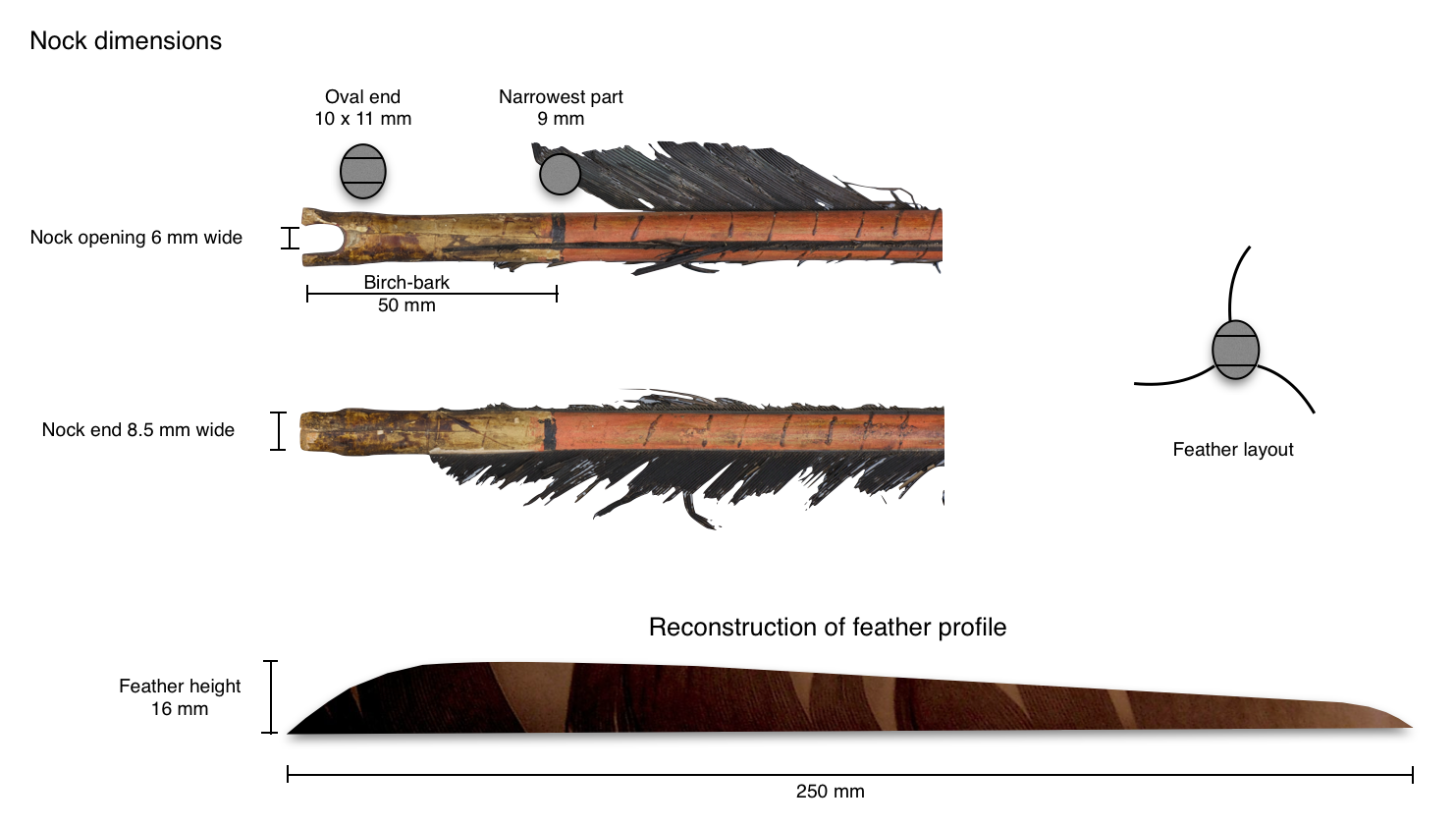
By Peter Dekker, January 30th, 2015.
Introduction
After the Manchus invaded China, the military of their newly founded Qing dynasty all adopted Manchu archery equipment. The Manchu war arrow thus because the standard military arrow of the Qing imperial army. This large and imposing war arrow is often compared to a small spear. They were long and heavy arrows, of standardized length, with a flattened triangular point on a long and slender steel neck. The Manchu bow is completely designed around such arrows, and it is the only bow that can shoot them as fast as it can for a given poundage. This bow-arrow combination was designed to deliver the greatest possible punch to the target, demobilizing it if not killing instantly. This focus on hard hitting single shots emerged from the Manchurian large game hunting tradition, where downing an animal with one shot was preferred over the ability to cast many lighter arrows. Also, these arrows are so large and heavy that not many of them could be carried, so they had to make their shots count. Originally their points were designed to hunt thick-skinned game like wild boar. The thick shoulder-plates of boar are like armor that protects its vital organs, and these arrows were designed to go through them. At some point, they must have noticed that these arrows went through human-devised armor with the same ease, and so over time the arrow became the standard war arrow of choice.

Sirdan, the Manchu war arrow
Sirdan
Instead of referring to their arrows as this-arrow and that-arrow, Manchus had separate names entirely for their various classes of arrows. Hunting broadhead arrows were called niru, long distance arrows were called tiyelin, etc. Their war arrow was called sirdan in Manchu and 戰箭 (zhànjiàn) in Chinese. In some 18th century dictionaries, the word sirdan is alternatively translated in into Chinese as "Plum needle arrow" (梅針箭 méizhēnjiàn) instead.1 At first I thought these two Chinese names were probably synonymous to each other, until I found both the plum needle arrow and the war arrow mentioned side-by-side in military regulations.2. With the méizhēnjiàn depicted in various illustrated texts, and some labeled examples still being preserved in the Palace Museum, we have a pretty good idea of what they are.3 Luckily we also have enough examples of (unlabeled) but clearly military arrows, mostly picked up at 19th century battlefields, to have a good idea of what the standard zhànjiàn or "war arrow" is as well. Basically, the so-called "plum needle arrow" was a better-made, more refined version of the simpler Manchu war arrow, yet similar enough to be referred to by the same name in Manchu. The plum needle arrows were only used by a the capital Eight Banners. Ulrich Theobald's research on the second Jinchuan wars sheds some more light on the matter: In the second Jinchuan war some 20.000 plum needle arrows were used, they were shipped directly from the capital to the war zone. In contrast, 478,500 war arrows were used in the same conflict.4. Let's first describe this most common type of Manchu war arrows, the zhànjiàn or war arrow.
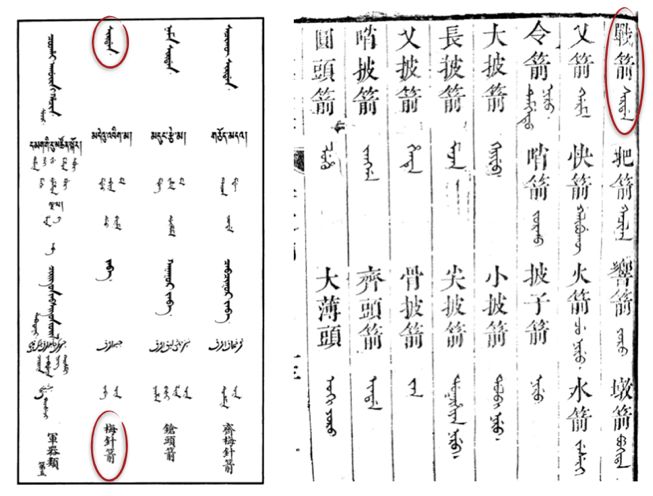
The word sirdan as it appears in the 1766 五體清文鑑 (Wuti Qingwen Jian) "Five language Compendium" (left) and the 同文廣彚全書 (Tongwen Guanghui Quanshu) or "Enlarged and complete dictionary" of 1704 (right).

"Sirdan"
戰箭
"zhànjiàn"
The "War arrow" type
This is by far the most common Qing dynasty war arrow found in museum and private collections. Most of them were taken to the Western world as war trophies from battlefields of the 19th and early 20th centuries like the Taiping wars, the Opium Wars and the Boxer Uprising of 1900. One such set is now in the collection of the Metropolitan Museum of arts. Their donator, George Cameron Stone, describes them:
“The Chinese bows are large and powerful... Bows of 150 pounds are by no means rare in China. The arrows used at the siege of the Legations in 1900 are 3 feet 5.5 inches long and 7/16 inch in diameter with heavy socketed steel heads.* [...] The bows that I saw in Peking that were used with such arrows were huge, about six feet long strung, with a cross section at the handle of nearly two square inches. They were said to pave a pull of about 200 pounds and looked it."
Source:
George Cameron Stone, Glossary of the Construction, Decoration, and Use of Arms and Armor in All Countries and in All Times, 1934.
Jack Brussel, New York, 1961. (Reprint) Page 134.
*3 feet 5.5 inches translates to 105 cm. A 7/16 inch diameter is about 11mm. Due to their shape, the heads look socketed but are actually tanged.
As standardized war arrows they are remarkably similar from piece to piece: Give or take a few millimeters, they are almost always 105 cm long and 11 or 12 mm thick, just like the ones mr. Stone described. The specimens I have examined weighed between 80 and 122 grams with most of them coming out at around 100 grams. There appears to be minimal deviation in weight between the arrows within one set. The shafts described in texts were usually made of birch and poplar, although some antique examples look and feel like their shafts could be oak. Like most Manchu arrows, the shafts are barreled, 12 or 13mm thick in the middle, tapering to both sides while flaring out again for the last few centimeters towards the a nock, with an oval cross-section at nock end. Some have simple self-nocks cut in the thick wooden shafts but most often the nocks are wrapped with sinew, which is in turn covered with birch bark. The space between the feathers was sometimes dyed red, as was the nock's hollow. They all have a heavy, tanged arrowhead with a triangular head on a long and narrow neck. The end of the shaft that holds the tang is wrapped with sinew and covered with black peach bark. The feathers are vulture or eagle, usually around 25 cm long and of moderate height. Sometimes the feathers are wound with very thin silk thread.
Antique war arrows
I have in my collection a set of antique war arrows I obtained from an old German collection. They still carry dirt and dried blood and the feathers -where present- are more ruffled than most arrows I have, suggesting they were probably picked up on a battlefield and taken home as war trophies after their unfortunate owners were defeated. The last battles of the Qing were much like the last scene of the Last Samurai, where traditional fighters, in this case Manchus, took bows and arrows to the field against modern firearms. Although according to period accounts they fought bravely, their equipment was just too outdated. A British commander who fought the Manchus in the late 19th century noted their bravery despite being at odds against Western firepower. He witnessed a whole Manchu garrison lose their life, the survivors of the initial battle all killed themselves out of shame or fear to fall into enemy hands. He wrote in his diary: “If this is war, I won’t have none of it anymore.”

The set of arrows.
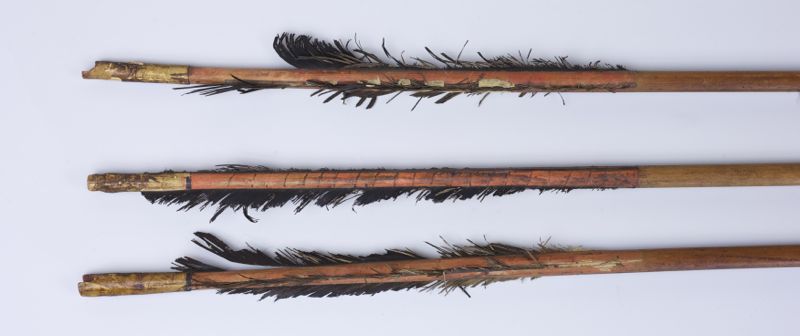
There is blood on the shafts between the feathers on the middle arrow, suggesting that its carrier was probably hit in the chest, his blood spraying on the arrows.
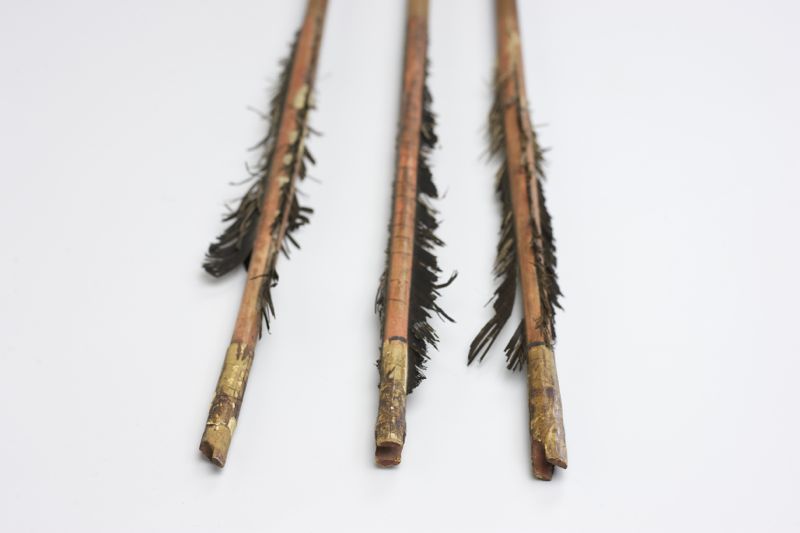
The nock ends.
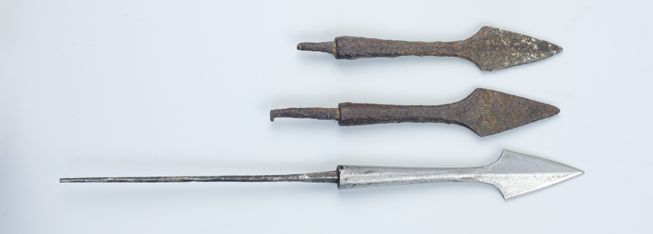
Three war arrowheads. Two were found in fields around Beijing, the other was taken to Europe and kept in near-mint condition.



Three views of a standard late Qing war arrowhead on one of the arrows.. Notice how the edges are flattened, not sharp. Instead of cutting, it rips the tissue open and delivers more of a "punch" to the target upon impact.
Detailed measurements
For those who are interested in reproducing Qing war arrows, or studying them in greater detail, I prepared the following schematics based on one of my arrows. Click the photo's to enlarge. Notice how the sizes are exactly those stated by George Cameron Stone in the beginning of this article.

"Sirdan"
梅針箭
méizhēnjiàn
The "Plum needle arrow" type
Plum needle arrows are described in court regulations and most extant examples can be found in old imperial Chinese collections such as the Palace Museum in Beijing, the Palace Museum in Shenyang and the Beijing Military Museum. This lead me to believe that they were a more expensive, elite version of the standard war arrow. And indeed, if the emperor or his guards would carry military arrows during for example the military inspections, it were always plum needle arrows. Regulations indicate that they were also issued to troops, but the absence of any quantity of plum needle arrows from later collections seems to suggest they gradually fell out of use for the bulk of the military. We don't know why exactly, possibly the cost was a factor.
Plum needle arrows are generally similar in size and shape to war arrows, being little over a meter long. Feather profiles vary, from large feathers to very low cut feathers. The nocks are sometimes finished with ray-skin or silk cocoon. Like on the war arrow, the steel arrowhead is approximately 10cm long and has a flattened tip on a long steel neck. The main difference is that plum needle arrowheads are more slender and with sharper edges than the standard war arrow. Some examples have beautiful facetted tips with up to ten facets on the neck 8 facets on their heads. Special, heavier plum needle arrows were worn by the night watch of the imperial retinue when camping. These were said to be able to pierce through even lamellar armor.

My somewhat younger self with a plum needle arrow from the Ingo Simon reserve collection in 2011. This collection is now held in the Manchester Archery Collection. Photo by Richard Hornsby.
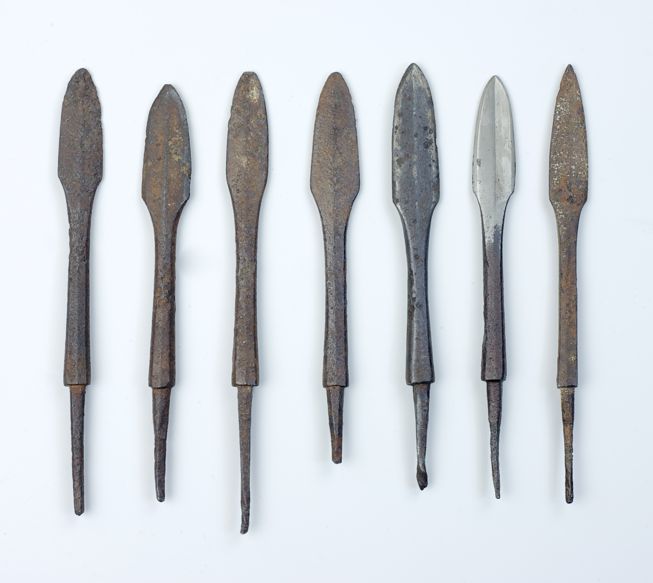
Various plum needle arrowheards from my own collection. The sixth was polished, revealing a tight forge-folded construction, just like on Chinese and Japanese swords.

The head of a war arrow compared to two plum needle heads. Author's collection.
Sub-types
As a response to various battlefield demands, many subclasses of sirdan came into existence. Most Qing lists of arrows will include at least three other varieties; the nama sirdan, sacikū sirdan, and kurcilehe sirdan.5
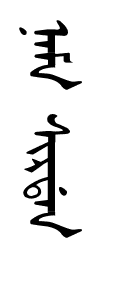
Nama sirdan
鎗頭箭 qiāngtóujiàn
"Spear headed arrow"
A special arrow with a spear-head like shaped head. These arrows were designed to be able to penetrate "plates of rattan". Rattan was a much used means of protection in the south where it was too hot and humid to wear armor comfortably. It found its way into shields, helmets and even cuirasses.


A Qing arrow with spearhead shaped head. This is possibly what a nama sirdan looks like.
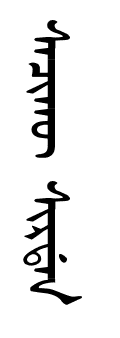
Sacikū sirdan
齊梅針箭 qí méizhēnjiàn
"Flat plum needle arrow"
A special type of plum needle with a clipped point, designed to pierce chain mail. Where other arrow types such as some Indian examples overcame chain mail with a long, slender point, the Manchu solution involved more of a chisel-like shape that was meant to cut through the rings.

Kurcilehe sirdan
火燎桿箭 huǒliáogǎnjiàn
"Scorched shaft arrow"
This arrow was especially heat-treated by wrapping the shaft with wood shavings and setting it on fire. This process was called kurcilembi. This hardened and heat-treated the shaft so it could be used in more humid environments. These arrows were also fitted with the spearhead type arrowhead, designed for the rattan protection worn in the hot and humid south of China.
FOOTNOTES
1 同文廣彚全書 (Tongwen Guanghui Quanshu) or "Enlarged and complete dictionary", a Qing imperial dictionary in Chinese and Manchu of 1704, each entry double checked and approved by the Kangxi emperor and 五體清文鑑 (Wuti Qingwen Jian) "Five languages compendium", a Qing imperial dictionary in Manchu, Mongolian, Uighur, Tibetan and Chinese of 1766. Published under the Qianlong emperor.
2 Both arrows are mentioned side by side in the 欽定軍器則例 (Qinding Junqi Zeli), regulations about the manufacture and maintenance of military equipment for all cities, garrisons and provinces. Compiled under the Jiaqing and Qianlong emperors.
3 Plum needle arrows are described in detail in the Qianlong era 皇朝禮器圖式 (Huangchao Liqi Tushi), a pictorial work listing ceremonial and military regalia including instruments, banners and weapons.
4 Ulrich Theobald, War finance and logistics in late Imperial China, a study of the second Jinchuan campaign (1771–1776), Leiden: Brill, 2013. Page 255.
5 Arrow descriptions put together cross-referencing the 皇朝禮器圖式 (Huangchao Liqi Tushi), 五體清文鑑 (Wuti Qingwen Jian) and Jerry Norman's Comprehensive Manchu–English Dictionary.



